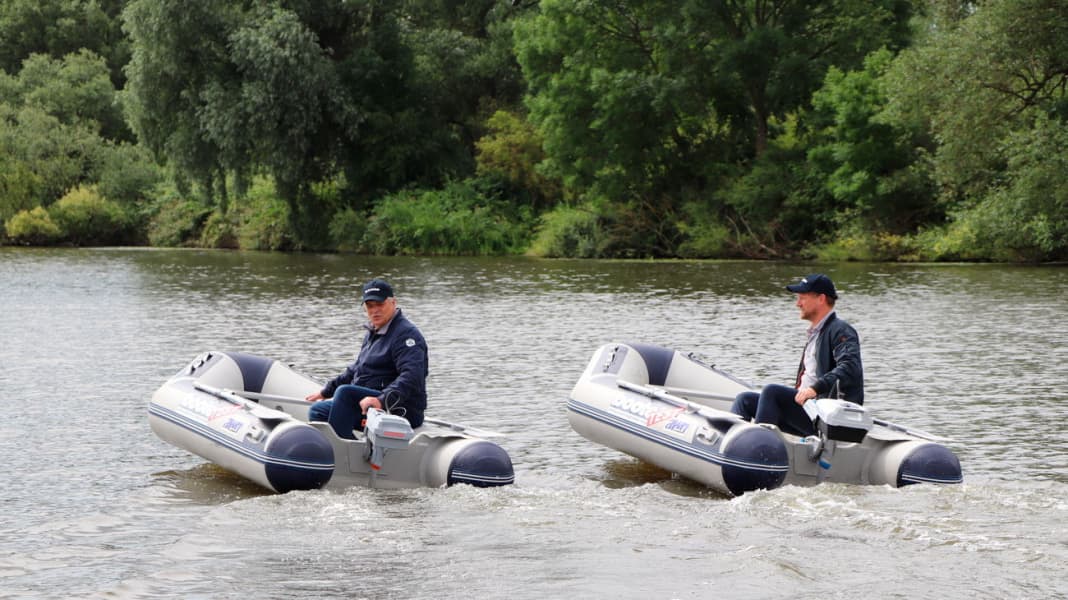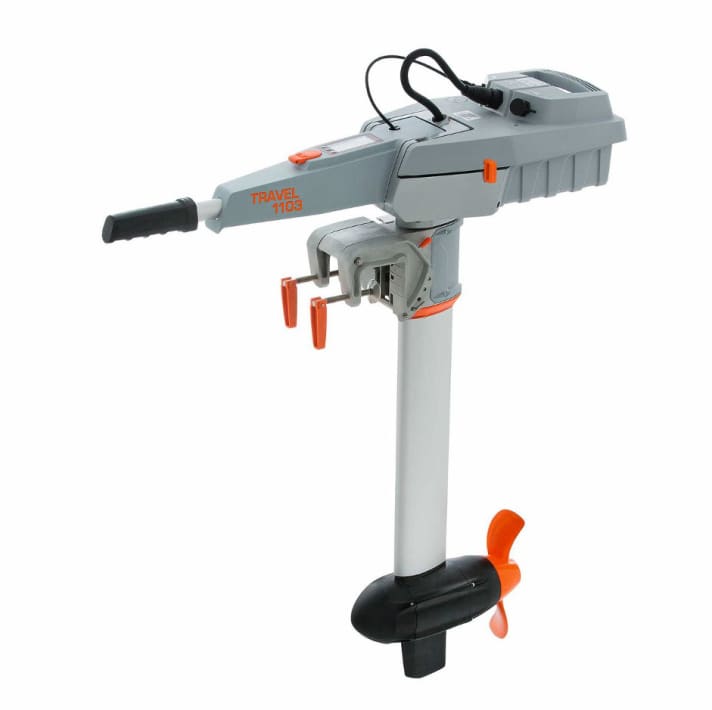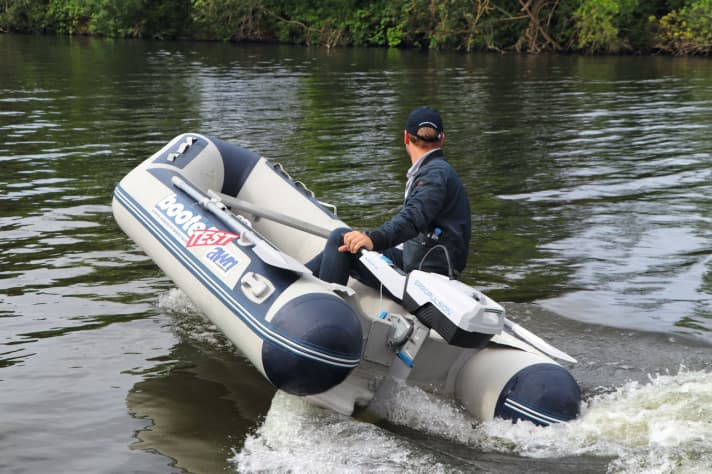
Floating almost silently in the dinghy from the anchored boat to the shore ... The quiet whirring of the electric motor can barely be heard over the lapping of the bow wave. No smell of petrol in the nose, no noise. And at the end of the trip: simply plug the battery into the charger. No more visits to the petrol station.
This is how we imagine electromobility on the water. Anyone who is enthusiastic about alternative drives will have great fun with the new generation of electric outboards, but an exploratory tour in an electric boat is also an exciting experience for fans of tried-and-tested combustion engines.
But can electric outboards be a real alternative to combustion engines? Especially in terms of performance and range? We put two models with an integrated battery through their paces: the Travel 1103 C model from the German manufacturer Torqeedo and theSpirit 1.0 from ePropulsion from China.
Electric outboard motors deliver at least 1000 watts
Both electric outboard models produce 1000 and 1100 watts respectively, which according to Torqeedo corresponds to a combustion engine of 3 hp. With a full battery, both manufacturers claim terrific ranges - and in fact, the Torqeedo predecessor model 1003 already demonstrated a far greater range compared to its 2.5 hp petrol cousins (and their 1-litre tanks) in the BOOTE comparison test in 2011. With one battery charge, it covered 20.5 kilometres at a speed of 5 km/h and four hours of driving. 4 kilometres further than the most economical combustion engine. With the 1103 C, the battery capacity was increased from 530 Wh to 915 Wh. But if you turn the throttle all the way up, the journey time shrinks to just under an hour. The heavier the boat, the more power is required and the shorter the range. This is why the small outboards are mainly used as a manoeuvring aid in harbours on sailing boats or inflatable boats. Reason enough for us to carry out the test on one of these.
Two identical, 3.20 metre-long high-pressure inflatable boats are to be compared directly. The first difference is immediately noticeable when mounting the transom: Both batteries are removable, whereby the Spirit 1.0's 1080 Wh battery not only has more nominal energy than the 915 Wh battery from Torqeedo, but is also a quarter larger. However, at 19 kg, the Spirit only weighs 1.3 kg more overall.

Just like similarly powerful combustion engines, such a small engine will not be able to reach really high speeds. The motors are therefore designed more as workhorses to push boats from A to B. High thrust in a lightweight design is the main task of both motors, as the ePropulsion (propulsion) already says with its name. Nevertheless, the Torqeedo with 0.31 kN thrust is ahead of the ePropulsion with only 0.29 kN in the digital bollard pull measurement.

To prevent the battery from going flat on the way back, both motors have a sophisticated monitoring display that is absolutely accurate compared to a test GPS.
The ranges displayed in the test also matched the distance travelled. However, while the Spirit indicates its range in hours and minutes, requiring the skipper to do a little mental arithmetic, the Travel 1103 C indicates its remaining range in kilometres. Despite the smaller battery capacity of the Torqeedo, it almost equals the range of the ePropulsion. However, the 100 watt more powerful Torqeedo wins in terms of top speed: while the Spirit 1.0 stops at 7.6 km/h, the Travel 1103 C can accelerate up to 9.0 km/h. However, the range drops very quickly. However, the range drops very quickly from an impressive 115 kilometres (at 2 km/h, rather controlled speed) to just 5.9 kilometres. What is impressive about both motors is that they deliver their full power right to the end despite dwindling battery capacity.
A speed of 5 km/h is required to get reasonably close to the destination. For this speed, the Torqeedo requires 186 watts of power and manages 23.7 kilometres on one charge. The Spirit 1.0, on the other hand, requires 200 watts, but can travel a good kilometre further.

The first Torqeedo models almost ten years ago repeatedly had problems with rapid changes from "forwards" to "reverse", which with the electric outboard (unlike the combustion engine) is simply done by turning the throttle grip via "neutral" in the opposite direction. It could happen that instead of reverse thrust, an error message appeared on the display and the motor electronics had to be restarted. A problem that Torqeedo has completely solved with the 1103 C. While delays of around 4 seconds could occur with the old 1003 model when quickly changing from "forwards" to "backwards", these are now completely negligible, averaging less than 1 second. The Torqeedo manages the sprint from standstill to "full speed" in just 9 seconds.

At first glance, the ePropulsion seems a little more lively than the Torqeedo, probably because the twist throttle is a little easier to turn. The Spirit also manages the quick change from "forwards" to "reverse" in just under a second, but when the change is repeated, the on-board computer suddenly displays the error code E10: "Engine blocked". The old problem. At slower speeds, the reaction time remains the same, no error code appears. The deceleration from a standstill is slightly less (0.5 seconds) than with the Torqeedo, and full speed is also reached after 9.5 seconds when sprinting.
In terms of driving power and performance, the two engines have little in common, but the higher power of the Torqeedo is noticeable. At very slow speeds, the Spirit's motor can only be heard as a slight whirring (43 dB), but at higher speeds it is clearly audible (61 dB at 5 km/h). The Torqeedo is completely silent when travelling slowly. Up to 5 km/h, our sound level meter probably only measures the wake, as nothing can be heard from the engine. Only at around 6.5 km/h does it start to hum from the shaft.
All in all, both motors are recommendable, but the Torqeedo is certainly more sophisticated. In terms of manufacturing quality, they are close to each other; in terms of price, the Torqeedo is slightly more expensive at 2249 euros than the ePropulsion at 1699 euros ( Prices and test engines from A.W.Niemeyer ).
In some of our websites we use so-called affiliate links. These are marked with an asterisk (*). If you click on such an affiliate link and make a purchase via this link, we receive a commission from the online shop or provider concerned. This does not change the price for you.

